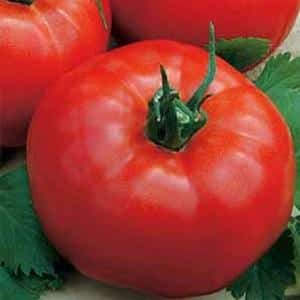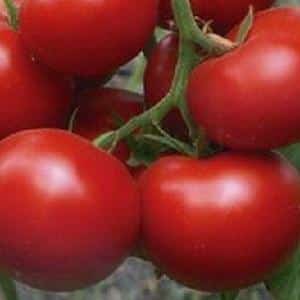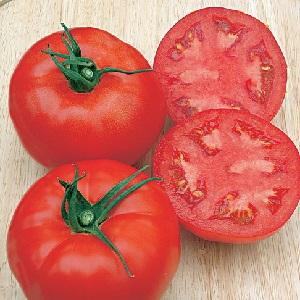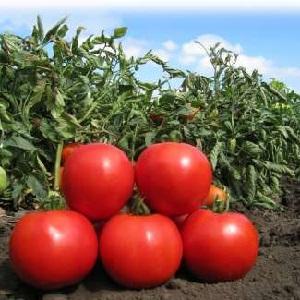The leader among early-ripening tomatoes, a favorite of farmers: the Katyusha tomato, characteristics and description of the variety
The ripening period of early ripening varieties averages from 60 to 90 days. Many people dream of getting a good harvest in such a short period of time. Tomato Katyusha is a bright representative of early ripening tomatoes. It is popular not only among novice gardeners, but also among experienced gardeners.
In the article we will consider the characteristics and description of the Katyusha variety.
Description of the variety
Katyusha is a hybrid domestic variety that appeared as a result of crossing other varieties. Year of creation: 2007. The tomato has excellent taste and ease of care.
Distinctive features
Katyusha ripens within 85-100 days from the moment of sowing. The crop is grown both in open ground and in greenhouse conditions. In a greenhouse, ripening time is reduced to 70-80 days.
The hybrid is resistant to drought and heat, while it tolerates high air humidity and rainy summers.
Bushes of the variety determinant - that is, they are limited in growth. The maximum height of one bush in open ground is about 80 cm, in a greenhouse - 1.5 m. The foliage is average, the leaves are dark green, small, and have an oval-pointed shape.
Characteristics of tomatoes, yield
The shape of the tomato is flat-round, even, with a smooth surface. The skin is thin, the pulp is juicy, there are few seeds. The color of a ripe tomato is deep pink. The weight of one varies from 110 to 130 g. Katyusha has high yields - from 1 sq.m of open ground, gardeners harvest about 10 kg of vegetables, in a greenhouse - 16 kg.
How to grow seedlings
To get a good yield from the harvest, you need to prepare the seedlings, following all the rules. Let us next consider the main stages of preparing seedlings.
Seed preparation
Among the variety of seeds on the market, it is important not to make a mistake with your choice. Experienced gardeners recommend carefully reading the information on the packaging before purchasing. It would also be a good idea to study information about seed producers on the Internet, or ask familiar gardeners about the advantages and disadvantages of a particular seed.
Before planting, it is necessary to disinfect the seeds. For this you only need gauze and potassium permanganate. Soak the seeds for 10 minutes in a 1% solution. This way you will avoid infecting the seedlings in the future.
To increase productivity, it is recommended to keep the material in nutrient preparations. “Epin” and “Immunocytophyte” products are excellent for this. There is a more budget option - potato juice or aloe juice. After the procedure, the seeds should dry; there is no need to rinse them with water.
Important! For earlier harvest, it is recommended to germinate the seeds. Place them in saucers and cover with gauze on top. The ideal temperature is about 25 degrees. It is important to ensure that the gauze does not dry out and is not too wet. The seeds should be kept in slightly moistened gauze for 3 weeks. Without prior germination, the seeds may rot in the ground.
Container and soil
 Any container is suitable for growing - wooden boxes, special plastic containers and even mayonnaise jars. The main thing is that the seeds have enough space to sprout. With soil, things are a little more complicated.
Any container is suitable for growing - wooden boxes, special plastic containers and even mayonnaise jars. The main thing is that the seeds have enough space to sprout. With soil, things are a little more complicated.
There are two ways:
- Prepare the soil yourself. To do this, mix clean soil, coal and humus. The proportion of this mixture is 2:1:1. Egg shells will be a useful addition. Don't forget to disinfect the soil. The previously mentioned potassium permanganate will help with this. To do this, pour a solution of manganese onto the soil and add antifungal drugs (for example, Fitosporin).
- Purchase prepared soil from a gardening store. Such soil should be loose and porous. Specially prepared mixtures also contain the necessary soil acidity and moisture level. Buying ready-made material will save time.
Sowing
Fill clean and dry containers with soil and make holes in them about 1-1.5 cm deep. The distance between the holes should be at least 5 cm.
Cover the top of the container with film or thin glass. This will help provide the plant with the required level of moisture. Place the container in a warm place - for example, near a radiator.
Growing and care
It is necessary to grow seedlings in a well-lit place. The ideal option is the lightest window sill in the house. If possible, use additional lighting with fluorescent lamps. Seedlings will develop faster if the seedlings are illuminated around the clock for the first few days after germination.
Young shoots must be constantly moistened. Do not remove the protective film or glass immediately, start opening it a little every day. The film can be completely removed approximately 10-14 days after the first shoots. It is also important to maintain the required level of moisture. Water the sprouts carefully, directing a stream of warm water directly under the stem. It is convenient to do this with a syringe or pipette.
Important! Check status seedlings It's best every day in the morning.If you see that the sprouts look sluggish and unhealthy, water them immediately. Otherwise, even weak rays of the sun can adversely affect the seedlings.
2-3 weeks after the first shoots, feed the seedlings. Organic fertilizers are suitable for this. In the future, you need to fertilize every week.
How to grow Katyusha tomatoes
To grow tomatoes properly, follow the basic rules.
Landing
Before planting, it is necessary to disinfect the soil. This can be done both with the help of specialized chemicals and with the help of folk remedies. Disinfection will protect against future diseases. If you grow the Katyusha variety in a greenhouse, then in addition to the soil, also treat all hard surfaces - walls and doors.
Tomatoes are planted in rows at a distance of 30-40 cm from each other. It is better to do this on a windless and cloudy day. The planting depth of the sprout is approximately 2-3 cm. After planting, do not forget to water the beds with warm water.
Care
Katyusha is unpretentious in her care. Due to their low growth, the bushes do not need staking, which greatly simplifies the cultivation of the crop. Water warm water, closer to the root. However, do not get carried away with excessive watering - excess moisture can lead to the development of fungus.
In addition to watering, it is necessary to periodically remove weeds and loosen the soil. This is necessary so that the required amount of air enters the soil. Katyusha does not need stepsoning, which is undoubtedly a big plus.
During the ripening period, at least three feedings will be needed - these can be either mineral or organic mixtures. Tomatoes are favorable towards ash and sawdust - they make excellent nutritional products and strengthen the immune system.
Features of cultivation and possible difficulties
 One of the difficulties is the likelihood of fungal and bacterial diseases. Microorganisms can appear due to excess moisture and heat. To prevent this from happening, preventive measures will be needed in the form of fertilizing and spraying by special means.
One of the difficulties is the likelihood of fungal and bacterial diseases. Microorganisms can appear due to excess moisture and heat. To prevent this from happening, preventive measures will be needed in the form of fertilizing and spraying by special means.
In order for the crop to tolerate changes in climatic conditions normally, they must be hardened even at the stage of seed preparation. To do this, wrap the seeds in cheesecloth and place them in the freezer overnight. Then remove and leave for a day at room temperature.
Repeat the steps several times, thereby the seeds will get used to weather changes. This is especially true for gardeners from central Russia.
Although the Katyusha variety is highly resistant to weather changes, in central Russia it is better to plant it in a greenhouse - this way there will be more harvest. If you live in the south of the country, you can plant the variety in open ground.
Tomato needs periodic nitrogen-containing fertilizing. However, too much nitrogen can lead to disease.
Diseases and pests
No seed manufacturer guarantees 100% immunity to viruses and pests. Katyusha, like other varieties of tomatoes, can get sick at any time. The worst enemy of tomatoes is late blight. It is a fungal spore that, after penetrating the plant, begins to slowly “kill” it.
It is easy to understand that a bush has contracted late blight - brown spots or white coating appear on the leaves. This disease spreads to other bushes very quickly, so it is important to detect the threat in time and remove the infected bushes.
Katyusha also suffers from tobacco mosaic or powdery mildew. These diseases occur due to a lack of nutrients or due to an excess of nitrogen and moisture. To prevent these ailments, take preventive measures in advance - then you won’t have to fight diseases.
Among the pests, we highlight the whitefly and spider mites. Parasites disrupt the metabolism of plants, take away all the most valuable things, as a result of which the crop dies. Although Katyusha has a high immunity to pests, prevention will not be superfluous.
The nuances of growing in open ground and in a greenhouse
 If you grow tomatoes in open ground, pay attention to the following nuances:
If you grow tomatoes in open ground, pay attention to the following nuances:
- take into account the climatic conditions of your region;
- the best predecessors for tomatoes are potatoes, cucumbers, cabbage;
- Don't plant bushes too close to each other.
When planting Katyusha in a greenhouse, remember:
- about disinfection of soil and all hard surfaces;
- bushes in the greenhouse develop faster, occasionally requiring the removal of stepchildren;
- High humidity may form in the greenhouse - ventilate it periodically.
Harvesting and application
The variety ripens gradually, which allows you to enjoy the harvest over several weeks and even months. The taste of the vegetable is sweet, the flesh is juicy.
Tomatoes are actively used in cooking dishes: soups, salads, side dishes, tomato juices, pastes and ketchups.
Also, due to their small size, tomatoes are suitable for canning and pickling. Katyusha does not lose its taste even after heat treatment. The variety can be stored for a long time and tolerates transportation well.
Advantages and disadvantages of the variety
Advantages of the Katyusha variety:
- high taste qualities;
- excellent yield;
- minimum care;
- immunity to diseases and pests;
- versatility in application;
- the ability to grow both in a greenhouse and outdoors;
- good transportability and keeping quality;
- resistance to weather changes.
The Katyusha variety has no significant disadvantages. Occasionally, growing becomes more difficult due to the large number of tomatoes on one bush, which can cause branches to break.
Reviews
 The tomato has won the love of many gardeners. For example, gardener Svetlana from Rostov-on-Don has been growing Katyusha for 5 years in a row. Svetlana says that this variety is her favorite, it does not require much time and effort, and at the same time produces excellent tasty tomatoes. The gardener recommends the hybrid to all his neighbors in the garden.
The tomato has won the love of many gardeners. For example, gardener Svetlana from Rostov-on-Don has been growing Katyusha for 5 years in a row. Svetlana says that this variety is her favorite, it does not require much time and effort, and at the same time produces excellent tasty tomatoes. The gardener recommends the hybrid to all his neighbors in the garden.
Summer resident Elena Katyusha has the same opinion about tomatoes - she likes the taste of vegetables, she uses Katyusha in preparing many dishes. In addition, Elena uses tomatoes in cooking blanks for the winter. The variety goes harmoniously with other vegetables.
There are almost no negative reviews about tomato - most gardeners characterize it only on the positive side. Some only note that it is necessary to apply timely fertilizing - there is not always time for this. Also, sometimes there are reviews that the variety became ill with late blight, and it was not possible to cure it.
Conclusion
If you want to grow a tasty and high-quality tomato on your plot, then the Katyusha hybrid fully meets these characteristics.
Even an inexperienced gardener can get a rich harvest, since Katyusha does not need special care. The tomato is versatile in use; it complements dishes with a sweet taste and pleasant aroma.